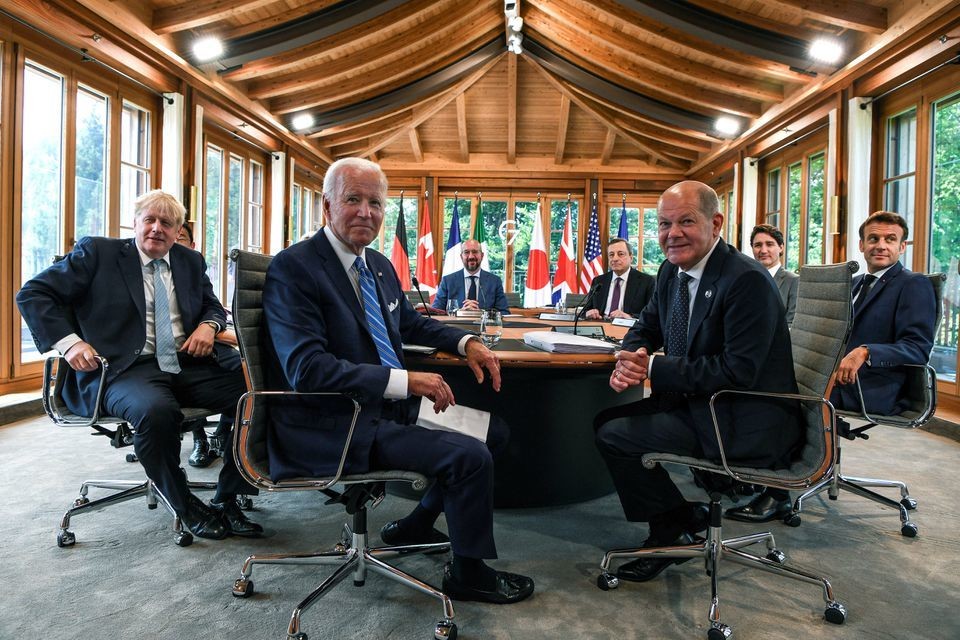- G7 leaders pledged to raise $600 billion in private and public funds over five years to finance needed infrastructure in developing countries.
- The investment will support projects in low- and middle-income countries that help tackle climate change and improve global health, gender equity and digital infrastructure.
- The scheme seeks to build a sustainable alternative to China’s older, multitrillion-dollar Belt and Road project.
- Some believe the pledges are a good start towards greater engagement by G7 countries in developing nations and could underpin stronger global growth.
Group of Seven leaders pledged to raise $600 billion in private and public funds over five years to finance needed infrastructure in developing countries and counter China’s older, multitrillion-dollar Belt and Road project.
US President Joe Biden and other G7 leaders relaunched the newly renamed “Partnership for Global Infrastructure and Investment,” at their annual gathering being held this year at Schloss Elmau in southern Germany.
Biden said the United States would mobilize $200 billion in grants, federal funds and private investment over five years to support projects in low- and middle-income countries that help tackle climate change as well as improve global health, gender equity and digital infrastructure.
“I want to be clear. This isn’t aid or charity. It’s an investment that will deliver returns for everyone,” Biden said, adding that it would allow countries to “see the concrete benefits of partnering with democracies.”
Biden said hundreds of billions of additional dollars could come from multilateral development banks, development finance institutions, sovereign wealth funds and others.
Europe will mobilize 300 billion euros ($317.28 billion) for the initiative over the same period to build up a sustainable alternative to China’s Belt and Road Initiative scheme, which Chinese President Xi Jinping launched in 2013, European Commission President Ursula von der Leyen told the gathering .
Infrastructure is one of the least technologically transformed sectors in the entire economy, with crucial components like construction ranking second to last in digitization according to industry rankings. Technologically-enabled infrastructure has the potential to change the way we plan, design, finance, build and operate our infrastructure systems and, more importantly, help achieve broader goals around sustainability, social cohesion and inclusive economic growth.
Image: Global Infrastructure Hub
The World Economic Forum’s Infrastructure 4.0 initiative, supported by the Global Infrastructure Hubis working to improve the adoption of emerging infrastructure technologies across assets and system lifecycles.
By creating recommendations for decision-makers and providing best-practice case study examples to the Global Infrastructure Hub’s G20 Infratech Use Case librarythis initiative aims to refocus the infrastructure development conversation around how infrastructure as a tool to provide better outcomes in people’s lives and technology’s role in enabling this people-first future.
The leaders of Italy, Canada and Japan also spoke about their plans, some of which have already been announced separately. French President Emmanuel Macron and British Prime Minister Boris Johnson were not present, but their countries are also participating.
China’s investment scheme involves development and programs in over 100 countries aimed at creating a modern version of the ancient Silk Road trade route from Asia to Europe.
White House officials said the plan has provided little tangible benefit for many developing countries.
Chinese foreign ministry spokesman Zhao Lijian defended the track record of BRI when asked for comment at a daily briefing in Beijing on Monday.
“China continues to welcome all initiatives to promote global infrastructure development,” Zhao said of the G7’s $600 billion plan.
“We believe that there is no question that various related initiatives will replace each other. We are opposed to pushing forward geopolitical calculations under the pretext of infrastructure construction or smearing the Belt and Road Initiative.”
Biden highlighted several flagship projects, including a $2 billion solar development project in Angola with support from the Commerce Department, the US Export-Import Bank, US firm Africa Global Schaffer, and US project developer Sun Africa.
Together with G7 members and the EU, Washington will also provide $3.3 million in technical assistance to Institut Pasteur de Dakar in Senegal as it develops an industrial-scale flexible multi-vaccine manufacturing facility in that country that can eventually produce COVID-19 and other vaccines , a project that also involves the EU.
The US Agency for International Development (USAID) will also commit up to $50 million over five years to the World Bank’s global Childcare Incentive Fund.
Friederike Roder, vice president of the non-profit group Global Citizen, said the pledges of investment could be “a good start” toward greater engagement by G7 countries in developing nations and could underpin stronger global growth for all.
G7 countries on average provide only 0.32% of their gross national income, less than half of the 0.7% promised, in development assistance, she said.
“But without developing countries, there will be no sustainable recovery of the world economy,” she said.
.



